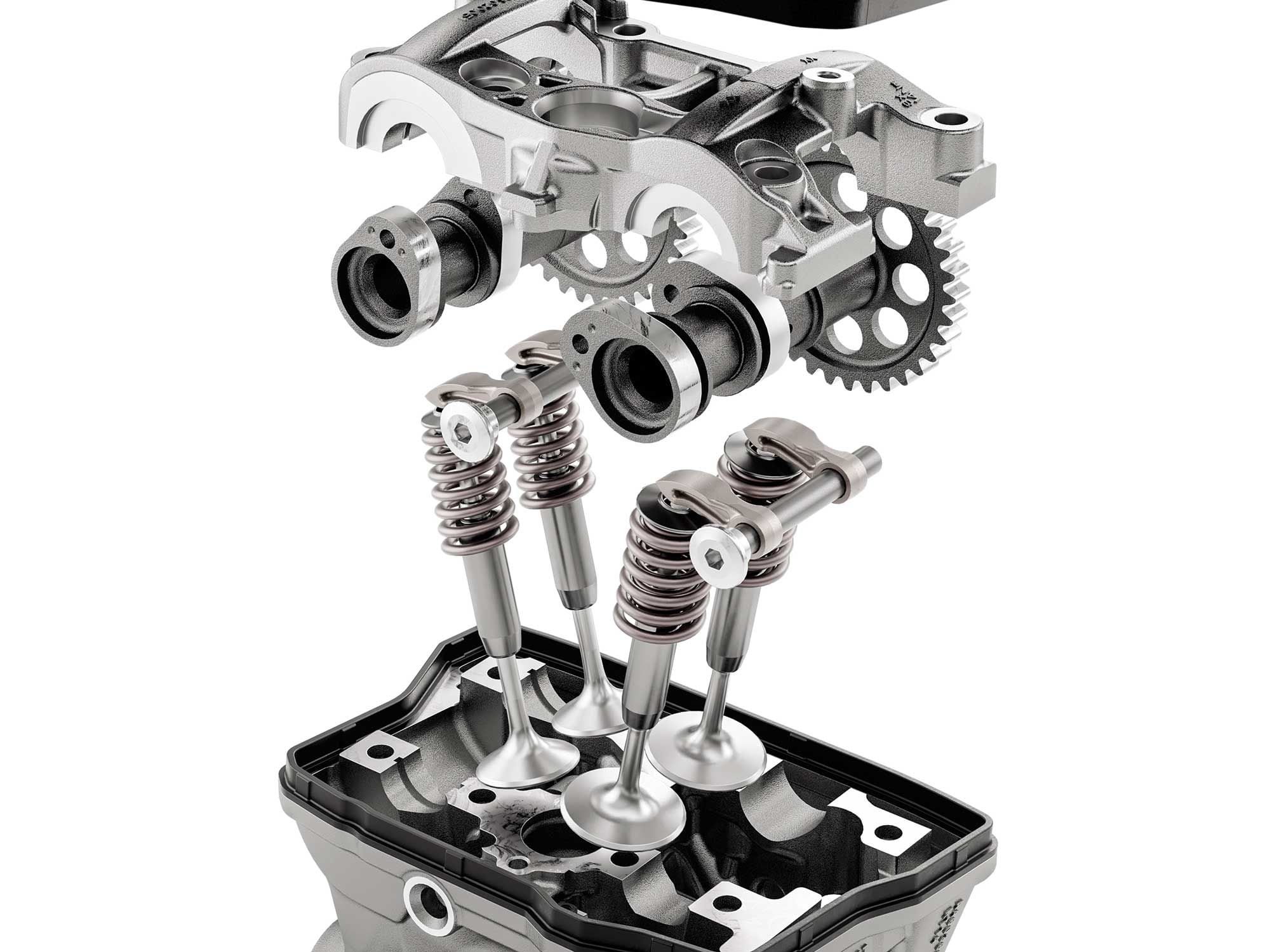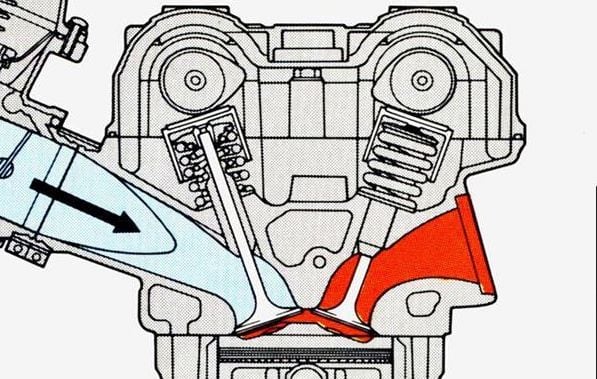
 |
|
|
#1 |
|
All the news that's fit to excerpt
Name: newsie
Location: who knows?
Join Date: Jun 2008 Motorcycle(s): only digital replicas Posts: Too much.
|
[cycleworld.com] - Narrow Valve Angle: How We Got There
Evolution and slow progress brought us the excellent cylinder-head designs we enjoy today.
Click here to view on their site.  What does a narrow-included-angle four-valve head look like these days? This KTM is a fine example. As engineers learned more and more, the included angle inevitably tightened up. (KTM/)Commenting on my three-part story addressing four valves per cylinder, Mr. Joe Broussard has very reasonably said, “An overview of the progression of development, like Kevin’s above, makes it seem so simple, [as if] all of us would be able to just change things for improvement…” He’s right. The adoption of four valves, narrowed valve angles, and flatter piston crowns took years to achieve. When Japanese manufacturers such as Suzuki and Kawasaki built 750 fours that outwardly resembled Keith Duckworth’s successful 1967 line of development, they were at first unable to improve their combustion. Rob Muzzy, aka “Mr. Superbike,” said it took them two years with a larger-bore, shorter-stroke new Kawasaki engine to equal the performance of the previous 68 x 51.5mm model (in racing form). Valve Angles Get Tighter In 1988 Suzuki jumped from 70 x 48.7mm to 73 x 44.7mm, but found it necessary to revert to the longer-stroke dimensions while further development took place. As a further example of development impeded by problems, there was Yamaha with its five-valve Genesis design, suffering sluggish combustion requiring 45 or more degrees of ignition lead in production form and even more when modified for Superbike racing. Honda’s Superbike “homologation special,” the 1988 RC30 V-4 750, had a valve included angle of 38 degrees. When that model needed updating, the resultant 1997 World Superbike champion RC45 was given a 26-degree valve angle. Ducati, on the other hand, had an agent in place at Cosworth (Duckworth’s company): the visiting and studious Massimo Bordi, who evidently understood how the new British combustion system worked. Over the next few years Ducati changed bore and stroke many times but made steady gains. Thus it was clear that there was more to the new Cosworth system than just four valves, a narrow valve included angle close to 30 degrees, a bore more than 30 percent bigger than the stroke, and a steeply downdraft intake angle. What did Ducati do differently? Knowing that the purpose of Duckworth’s design was to speed up combustion, Ducati used an in-cylinder anemometer very like the one used decades before by Harry Ricardo, the British IC-engines pioneer. With the anemometer reporting the rapidity of charge “barrel motion” or tumble, Ducati could vary intake-port diameters and alter the degree of intake downdraft to achieve the charge motion necessary for rapid combustion. Speeding Up Combustion Time To briefly review, the time taken by combustion determines how long hot, high-pressure combustion gas is held between the piston crown and combustion chamber, constantly losing heat to those metal surfaces. More rapid combustion means less heat is lost in this way, resulting in higher gas pressure and greater torque. With respect to port diameter, many investigators have found that midrange power (and therefore acceleration) are sensitively dependent upon intake velocity, for intake velocity determines how long after BDC intake flow can continue to coast into the cylinder against the rising piston. The measure of how much energy is present in the flow to later become combustion-accelerating charge turbulence is the square of that intake velocity. In Des Hamill’s book Coventry-Climax Racing Engines, he describes how missing midrange in a development engine was restored by sleeving its intake ports with shim stock. David Vizard, a popular IC-engine author and airflow specialist, noted that the critical part of the intake system is that which would be filled by pouring a volume of liquid equal to 15 percent of the cylinder’s displacement into it (with closed valves, naturally). At least one major Superbike team has made color-coded interchangeable intake port sleeves of different diameters for development purposes. And finally, consider the intake downdraft angle. This factor determines how much of the intake energy will become pressure in the cylinder, and how much will remain as high-speed tumble motion. The steeper the downdraft, the more emphasis is placed upon cylinder filling.  Honda’s RC30 V-4 was pretty exotic for a 1988 streetbike, with its 38-degree included valve angle and compact combustion chamber. But just a few years later, when the RC45 showed up, the valve angle had narrowed to 26 degrees. (Honda/)From the information I’ve been able to gather, it would appear that many racing organizations gradually discovered the value of narrowed valve included angles and flatter, less obstructive piston crowns in successive designs. In each case, someone observant had to take notice of the trend. Narrower and Narrower Honda, in its 1959 two-valve RC142 125cc twin, used a conventional-for-the-time 84-degree valve included angle. By 1962 the included angle was down to 76 degrees in the four-valve RC110. By 1964, the 50cc RC113 engine was at 72 degrees, and there was a jump to 56 degrees with the 1965 RC115 (also a 50). In England, Climax’s four-cylinder two-valve FPF was at 66 degrees (included) by the late 1950s, but when that company issued its FWMV 1.5-liter V-8 (also a two-valve design), it chose 60 degrees for the angle (design began in late 1960). And when the never-raced but extensively developed flat-16 FWMW ended the line, it was given 48 degrees when design began in 1963. Over at MV Agusta in the early 1970s the included angle given to the first of its new GP racing fours by engineer. Giuseppe Bocchi was 55 degrees, with a further step down to 35 degrees. So far, no one has revealed why this change was made. Was it driven by knowledge of Duckworth’s DFV F1 engine of 1967? Was it a response to slow combustion and high cylinder-head temperature? We don’t know. Narrower Means Cooler Too On April 1, 1947, engineer Bert Hopwood began work at Norton, designing a new 500cc parallel twin. Did he give it the 90-degree valve angle of the classic Triumph Speed Twin, the inspiration for all British twins? Did he give it the lesser but still traditional 77 degrees enshrined in Norton’s classic Manx racing single? No. Possibly what he described as “…my experience at Triumph of excessive cylinder head overheating problems…” were his motivation when he drew up the cylinder head for the Dominator. In that design, by cutting included angle to 58 degrees, he reduced the combustion-chamber depth and therefore chamber and piston-crown area as well. In 1970, during the development leading up to their classic XR-750 dirt-track V-twin, Harley-Davidson began by building and homologating 200 iron 750s based on the 90-degree-valve-angle heads and deep chambers of the XLR. These, in turn, were taken from Offenhauser’s Midget engine, which traces its lineage back to the 1912 Peugeot! That year at Daytona the first iron XRs overheated and detonated so destructively that a crash program of improvement was set in motion. The tall piston dome required to reach a reasonable compression ratio so interfered with charge motion that the engine required 50-55 BTDC ignition timing. Such slow combustion and the low-conductivity iron cylinder and head material added up to high cylinder-head temperature and detonation. Accordingly, for the quick-fix iron XR for 1971, the valve included angle was cut by 22 degrees, valve and port sizes were reduced, and the piston dome was lowered. It was with one of these second-year iron engines that the late Calvin Rayborn dominated the Trans-Atlantic Match Races that year against the cream of British short-circuit riders. Ignition timing was reduced to 35 BTDC by the redesign. The Path Forward Imagine, as Mr. Broussard rightly urges us to do in his comment, the time, expense, and effort required to advance all these programs. One of them, Keith Duckworth’s, has been chosen by history as definitive. If you read Duckworth’s official biography First Principles, you will see that he was simply trying to find his way forward against the usual troubles, just as were those responsible for the other programs described above. None of these engineers was standing on a high peak, clearly seeing a distant solution gleaming like sunrise on the far horizon. Mr. Broussard also refers to the possibility of having to build and test 100 different designs. That was just what BMW did when it resumed participation in F1 in 1999–2000—built and tested roughly 100 V-twin test engines covering a range of design concepts as a basis for the V-10 it actually raced. Time, money, and a steady flow of ideas required.
__________________________________________________
I'm a bot. I don't need no stinkin' signature... |
|
|

|
 |
 Similar Threads
Similar Threads
|
||||
| Thread | Thread Starter | Forum | Replies | Last Post |
| [cycleworld.com] - Four-Valve Beginnings | Ninjette Newsbot | Motorcycling News | 0 | July 6th, 2022 02:14 PM |
| [cycleworld.com] - Valve Lift | Ninjette Newsbot | Motorcycling News | 0 | June 22nd, 2022 10:40 AM |
| [cycleworld.com] - Answering Readers: Five-Valve Engines and Chatter | Ninjette Newsbot | Motorcycling News | 0 | April 22nd, 2022 03:44 AM |
| 300 air switching valve and purge valve (CAL) removal | joyspring | 2013 - 2017 Ninja 300 Tech Talk | 21 | February 13th, 2017 01:36 PM |
| Fixed valve cover bolt leak & valve clearances | Linkin | Videos | 3 | June 24th, 2015 03:49 PM |
|
|